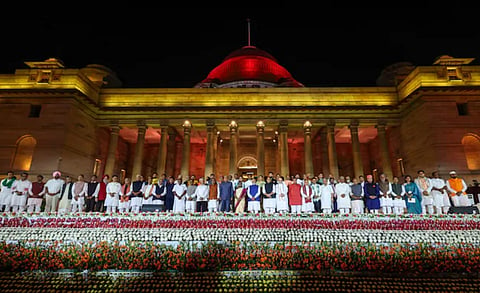
New Delhi: Seventy-one Union ministers were sworn in alongside Prime Minister Narendra Modi on June 9. The new cabinet includes 10 Dalits, 27 from the Other Backward Classes (OBCs), 21 from “upper” castes, five from tribal groups and five from religious minorities. However, there are no Muslims in the current lineup.
During the previous Bharatiya Janata Party (BJP)-led National Democratic Alliance (NDA) government, Mukhtar Abbas Naqvi served as the minority affairs minister but resigned in 2022 when his Rajya Sabha term ended. Smriti Irani replaced him, and currently, no Muslim minister has been sworn in, as no MPs belonging to the community were elected to the Lok Sabha from the NDA this term.
The five ministers from minority communities include Hardeep Singh Puri (Sikh), Ravneet Singh Bittu (Sikh), George Kurian (Christian), Kiren Rijiju (Buddhist) and Ramdas Athawale (Buddhist). Puri and Athawale are Rajya Sabha MPs, Rijiju won the Lok Sabha election from Arunachal Pradesh, Bittu lost in Punjab and Kurian, BJP’s general secretary in Kerala, did not contest.
In 2019, 57 ministers were sworn in, comprising 32 from “upper” castes, 13 OBCs, six Scheduled Castes (SCs) and four Scheduled Tribes (STs). The Council of Ministers was expanded in 2021, and it included 27 OBCs, 12 SCs, eight STs and 30 from “upper” castes. The current representation of “upper” castes has decreased, particularly after many candidates from this group lost in Uttar Pradesh.
Inclusion of ministers in Modi’s second term that represented the saffron party’s focus on tribals and Dalits include Virendra Kumar, Thawar Chand Gehlot and Ram Vilas Paswan. Kumar, having succeeded Gehlot as the minister for social justice and empowerment, retained his cabinet position after winning his eighth Lok Sabha election from Madhya Pradesh.
New Dalit ministers include Chirag Paswan and Jitan Ram Manjhi. Arjun Ram Meghwal from Rajasthan, who previously served as the law minister, has been appointed as minister of state (independent charge). Additional ministers of state include Athawale, SP Singh Baghel, L Murugan and Kamlesh Paswan.
The number of Dalit ministers has been increased visibly keeping in mind the saffron party’s significant loss of votes of the marginalised group. It also highlights the representation of religious minorities like Sikhs and Christians.
The number of ministers from tribal groups remains at five, similar to the 2019-2024 term. Among them, Jual Oram from Odisha has been elevated to a Cabinet minister. Despite Arjun Munda’s loss, other tribal ministers include Sarbananda Sonowal, Savitri Thakur and Durga Das Uikey.
Bihar, having elected 30 MPs from the NDA coalition to the Lok Sabha, now has eight ministers, with three from OBCs, three from “upper” castes and two Dalits. This representation aligns with the state’s significance for the BJP and its ally Janata Dal (United), ahead of the Assembly elections next year.
Notably, two Bhumihar ministers, Lallan Singh and Giriraj Singh, have been included. Other representatives include Rajya Sabha MP Satish Chandra Dubey (Brahmin), Ram Nath Thakur (extremely backward castes), Raj Bhushan Nishad (Mallah community) and Chirag Paswan and Jitan Ram Manjhi (Dalits). No Rajput or Kushwaha ministers were included.
In poll-bound Haryana, influential Ahir OBC leader Rao Inderjit Singh has been reappointed. Other ministers include Krishan Pal Gurjar and former CM Manohar Lal Khattar. The BJP has not included any ministers from the Jat community, reflecting the party’s loss of support among Jats, OBCs and SCs as noted in a CSDS-Lokniti post-poll survey.
The BJP’s seat tally in Maharashtra and Uttar Pradesh reduced significantly from 2019. However, despite a reduction in the number of MPs, the state retained significant representation in the Council of Ministers, with nine ministers, including Rajnath Singh, Anupriya Patel, BL Verma, SP Singh Baghel and Pankaj Chaudhary. Newcomers include Jitin Prasada, Jayant Chaudhary, Kirti Vardhan Singh and Kamlesh Paswan. Hardeep Singh Puri is a Rajya Sabha member from Uttar Pradesh.
In Maharashtra, six MPs were picked as ministers, including Nitin Gadkari, Piyush Goyal, Raksha Khadse, Pratap Rao Jadhav, Ramdas Athawale and Murlidhar Mohol, with the names of Narayan Rane and Bhagwat Karad dropped.
In Rajasthan, despite losing 13 Lok Sabha seats, Bhupendra Yadav, Arjun Ram Meghwal and Gajendra Singh Shekhawat retained their positions, with Bhagirath Choudhary being the only new addition.
Southern states also saw representation, with Telangana electing eight BJP MPs, two of whom were appointed ministers — Bandi Sanjay Kumar and G Kishan Reddy. In Kerala, BJP inducted Thrissur MP Suresh Gopi and George Kurian.
Andhra Pradesh will have three ministers from the BJP-TDP alliance. Karnataka’s cabinet includes HD Kumaraswamy and Shobha Karandlaje from the Vokkaliga community and V Somanna from the Lingayat community.
You can also join our WhatsApp group to get premium and selected news of The Mooknayak on WhatsApp. Click here to join the WhatsApp group.